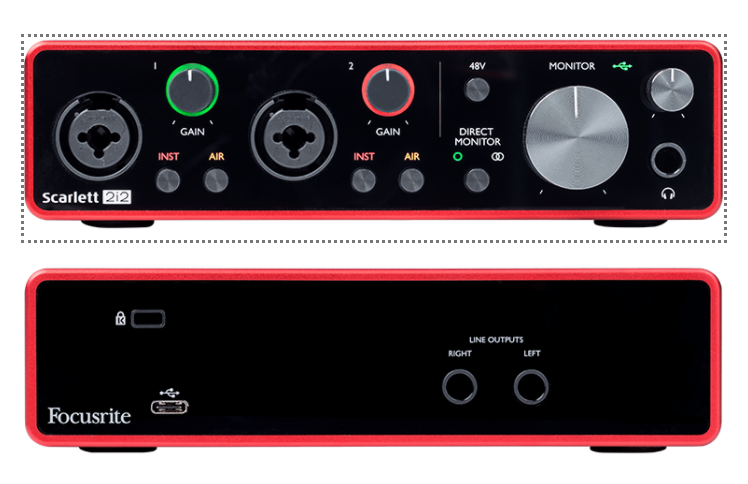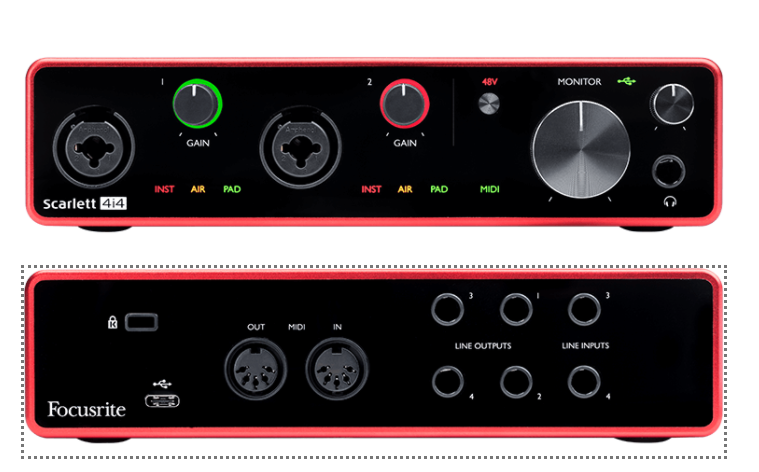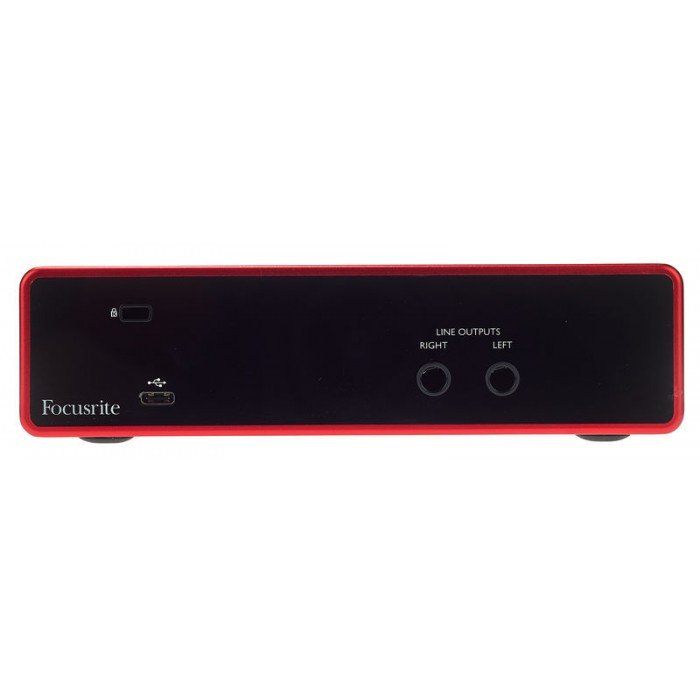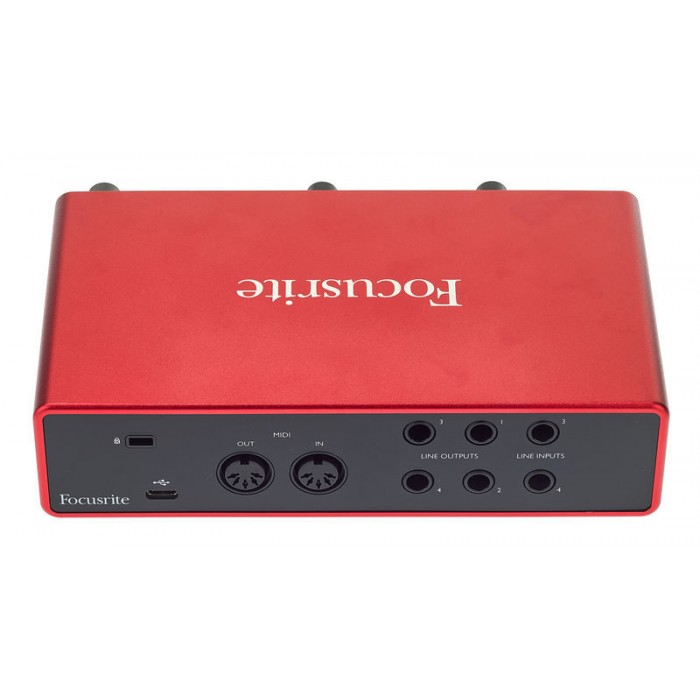-
Posts
318 -
Joined
-
Last visited
Posts posted by Marcello
-
-
Hi there.
I'm having an issue with changing the samplerate.
I bought a new Focusrite Scarlett 2i2 audio interface.
I open my project in Cakewalk and I want to change samplerate from 41000 to 48000, so I go to preference and change it, all good.
Then I should set the samplerate also on my audio interface application (which is external to the daw), which apears to be set to 41000 by default.
I change it there but then when I open the daw, in the interface application it's changing back to 41000 by itself (while on Cakewalk remains 48000 in preferences)
only when I open Cakewalk the samplerate in the Focusrite app changes back to 41000.
Any idea how come??
-
-
1 hour ago, rsinger said:
If you get the DD-200 and you do a second take note that you can use the boss as a DI. It's designed to take a guitar as input. Use it between the guitar and IF and bypass the effect and see if it improves the sound on the first take.
This won't work with all guitar pedals. A lot of pedals are designed for instrument level signals. You don't want to put a line level signal into those. It all depends on the pedal; some will work some won't, some may blow out.
Also check and see if the tube in the audient is running at full voltage or if it's starved. Starved is ok, but you may be disappointed if you think it's full voltage and it's not.
Thanks for the tips, so how do you understand if the pedal is ok for line level signal? Didn’t get that
-
15 hours ago, rsinger said:
OK, that's a bit simpler. The input on the DD-200 is -10 db to + 7 db and +4 db is a common line level so you should be able to take the output of the IF directly into the delay. The output is the same -10 db to + 7 db so you can go directly into the IF. You need at least two inputs and outputs to record guitar and use outboard fx and as you say to get stereo you need two inputs and outputs for the delay. I haven't used outboard fx with CbB. There is a section in the documentation on it. Search the pdf version for external insert. It's on page 928 of version 26.11.00 .
Right I get it man, so I’m out of budget for buying a interface with 3 inputs, so I might renounce to record and re-amp at the same time, I will do that in a second take.
So basically you need the re-amp box just if you use a real amp but not just for the effect pedals. So no need of a re-amp option neither in the audient interface, at this point it’s just a simple choice between the focusrite 2i2 and this audient sono. The only cool thing about the audient is that is a tube preamp, so you can go directly into the DAW with a warm tube guitar sound, but at that point I don’t know how much sense it has to use the amp sim, since the interface would have already its own sound, and I ‘m afraid I would be limited by that. -
3 hours ago, rsinger said:
Are you re-amping or do you want to use the DD-200 as an external effect? What you describe here and the other post is an external effect, you're not going into a HW amp r u? You write that you're using an amp sim.
Exactly
-
10 minutes ago, John Vere said:
Why are you double posting?
This post is about using the boss pedal as re-amp, it's a different question.
-
 1
1
-
-
-
-
Check out this also
-
 1
1
-
-
Hi guys,
so I'm recording at home my guitar with Cakewalk, using an Amp sim in within the DAW from Overloud.
Now I would like to use my DD-200 Boss pedal as an effect instead of the plugins within the DAW.
For convenience I would like to be able to re-amp the delay effect for the following reasons:
- The effects should sound better after distortion (amp sim in my DAW) as it is usually placed at the end of the signal chain
- If I place the delay effect before the audio interface and before getting into my daw the guitar will be recorded with the delay, not clean, this means that if I would like to change the delay settings after recording for some reason (like delay time, intensity, type or whatever) or maybe because I notice some mistake, I will need to record everything again, while if I re-amp the delay I can re-play the clean track recorded in my daw, and re-amp it back with the delay where I would be free to change the settings.
Now, I have read that instead of buying a re-amp box, I could use whatever Boss pedal (like my boss tuner for instance) as a reamp box, because apparently it has the same functionality, watch the video here: https://www.youtube.com/watch?v=n-RUSK9nOeQ
Can you confirm this can be done?
Also, since I have an interface with only one input, it's a really basic Seinberg UR12, I would need to buy a new audio interface so that with 2 inputs/outputs I can re-amp it.
I'm just a bit struggling to understand which one would better fit for my needs.
I would like, if possible, to be able to not switch cables and do re-amping in the second step after recording, but I would like to be able to do that simultaneusly, with that I mean recording the clean track while reamping at the same time, because I would need to hear the Boss DD-200 effect while I record the track.
So based on these infos, how many output/inputs I would need to have in my audio interface?
I'm considering these 2 models, of course there is a big difference in price, so I would like to get the Focusrite 2i2, but not sure if with those 2 line outputs would be enough,
maybe I could use the headphone output to be able to listen to the track while I record, and the 2 line outputs on the back to re-amp? Or do I need to get the 4i4 Focusrite?
Please notice the delay pedal effect would be better recorded in stereo, in any case I should also consider the price difference, if it worth it.
2i2

4i4

-
 1
1
-
-
2 hours ago, John Vere said:
What many do like me is record the wet live signal with the effects and split it ( at my Boss tuner). And record a second track dry at the same time.
Best of both worlds. But I almost always use the wet track. Myself I need to “play” the effects especially delay.ah ok, so you split one guitar signal to the delay and one to the interface directly through the Boss tuner, I get it, but this doesn't solve the problem you cannot anyway change the delay amount/time/delay type and all the pedal settings, if you make a mistake or you figure out something after you recorded and you want to change it, you have to record it again.
What you are doing is to record a track with delay and one without it, but still you are recording with the delay, while if you use the re.amp box you can just play the "clean" guitar already recorded in your DAW and press REC on the empty track where the delay effect is applied and redirected through the re-amp box.
Not sure I explained myself.
Also in any case you are firstly passing through the delay pedal first, not after, which still by default the distortion should be applied before the effects.
-
9 hours ago, Base 57 said:
Typically the Boss delay pedal goes before the amp.
If you want to route a recorded track back through the pedal then you should use the reamper. But nothing is forcing you.
If you are looking to track through the amp sim then loop back through the pedal while playing live, latency will be too much without a very fast computer and interface.
mmm, I get it guys, I understand what you are saying but I'm a bit sceptical.
Anyway I asked a friend who has a recording studio, the difference is that if you place the delay pedal before everything, after recording you cannot change anything, if you made a mistake, you have to record it again.
For instance you didn't set up the delay time properly with the song, or you want to change something, maybe too much delay or too less, you have to record again everything, while with the re-amp box you can always change the delay settings after recording because you recorded the clean guitar without effects.
In terms of sound is relative, usually it should go after the distortion, but as you said someone use it before, it shouldn't be a big deal.
So this is the main issue, not the sound.
I might buy it at the end.
-
1 minute ago, John Vere said:
So why don’t you do like I do and plug your guitar into the pedal and record it. As I said I will mostly record this way. Amp sims come in handy but they are not a replacement for the real thing.
Even if you bought the re amp device it might sound horrible and that would suck.
Sorry I didn’t explain myself well maybe. I won’t record with a real amp, because I’m home recording and I live in a condominium, so I just can’t, I don’t have a studio.
I use the amp sim from Cakewalk, which is great, and my guitar jack goes directly into my interface.
Now I want to use my delay Boss pedal, as an effect, and that should go after the amp, not before, at least if I want to record a proper sound correct???
then I should need a re-amp box correct?
-
1 minute ago, bdickens said:
You're really overthinking it.
I can't tell you how many guitarists have a delay pedal in front of a distorted amp.
I know! But since I’m recording an album is pretty different from just playing live.
-
20 minutes ago, John Vere said:
The easy way out is just use a delay pedal in the box. Which amp sim are you using? There are lots of options. Problem solved. There's nothing special about the boss delay pedal. I find it a bit grainy compared to the Mooer.
I understand, I could use the Overloud plugin effects and save money, they are ok. But on this particular delay pedal there is an amazing shimmer delay sound much better than that in Overloud. So maybe I’m making too much mess for this shimmer delay, but sound so good, and also the way I have to play this shimmer delay is like a violin sound, so I use the Ernie ball volume pedal together with the delay to make this Orchestra violin sound with the guitar, that would be impossible to play from within the plugins in my daw.
-
15 minutes ago, John Vere said:
The easy way out is just use a delay pedal in the box. Which amp sim are you using? There are lots of options. Problem solved. There's nothing special about the boss delay pedal. I find it a bit grainy compared to the Mooer.
-
On 11/9/2021 at 6:58 PM, rsinger said:
You'll find plenty of delay pedals on pedal boards.
There's a memory man and Belle Epoch on Eric Johnson's pedal board. They're before the amp. Try it and see. You run into problems if you want to push the amp's input or you're driving the amp really hard.
Interesting comment from EJ -
The HUB: Does your setup change at all for studio recording?
EJ: It’s pretty much the same. I mean, I’ll use different pedals in the studio that I normally wouldn’t use live just for overdubs or something, but typically that’s the go-to sound that I could kind of cover everything I need to and, if I need to change it from there, it could be just a matter of setting the tone different, treble or bass or whatever, or different guitars.
I don’t do live, only studio recording. I don’t care about live, I’m talking about the studio recording, normally the delay should be placed after the distortion, since I’m not using a distortion pedal But an amp sim software, or normally I anyway always use the amp distortion, then I need to go from my DAW to the delay pedal, then back from the delay to the DAW again through my audio interface, this is possible only with the re-amp box.
now Im just wondering whether this big change in sound quality worth the money cause I have to buy a new audio interface and the re-amp box, everything would cost 200 bucks.
not sure it’s clear enough -
On 11/9/2021 at 4:35 PM, msmcleod said:
It depends... if your pedal has a line level input, then you don't need a re-amp box.
If it's just got a HiZ guitar input, then you will need one. Most of the time you can get away with a passive DI box rather than a dedicated re-amp box.
You should be able to get a passive DI box for around €15 - €20.No it doesn’t it’s a simple Boss pedal with jack input. I didn’t understand why the DI box would be fine, I thought I read that’s for other stuff, the re-amp box is what I need, not DI box. I found one for 60 euros
-
18 hours ago, John Vere said:
Myself if I’m using a pedal it is going to be where it was designed to go. Directly from my guitar and Before my amp.
I rarely record electric guitar directly because electric guitar needs an electric guitar pre amp to respond to. The whole thing with playing electric guitar is the pick ups, the pedals and the amp all reacts to your playing. And your playing is effected by the sounds you’re getting. You play to the effects.
My preferences is to use my pedals and amp to get the sound I want and record it.
But sometimes your not dead sure and then a boring dry guitar track might work better. I often record both the amp and a dry signal. My Boss tuner has 2 outputs.
Some interfaces offer a dedicated hi z jack which is a decent option if your plugged in directly.
If I do go direct I use a Zoom multi effect pedal last in the pedal chain. My delay pedal is second last My overdrive pedals first.If I want clean and dry I just put the Zoom on bypass mode. The Zoom seems to give me a better punchy track than if I go directly from my guitar.
But the thing is there are no rules you can’t break. So just try it. It will either give you a sound you’re after, or suck.This is because you are using the distortion pedal and you can place it before the delay, I use the amp distortion so the only way to place the delay after the amp is to use a re-amp box.
-
Hi there!
I'm recording some stuff at home and I have purchased a very cool delay pedal for guitar I would like to use in some of my tracks.
I'm recording with cakewalk and and amp sim from Overloud.
Now, I don't have a re-amp box in order to place my delay pedal after the amp sim in my DAW, as it is usually recommended.
Is it really much better in terms of sound quality to place the delay pedal after the amp with the re-amp box?
Or is just fine for the guitar to pass to the delay pedal first and then to the amp sim in the daw?
Do you suggest me to buy a re-amp box?
Thanks in advance.
-
This is the track, is it too quiet in your opinion? try to compare it with some other references.
Skip the first part is only solo
https://drive.google.com/file/d/1VNQJSj152Zxw1PFJGIHYQAMPEb89fZY9/view?usp=sharing
-
On 7/23/2021 at 8:10 PM, NOLAGuy said:
@MarcelloI just got a notification yesterday from PluginBoutique.com (a legitimate site handling only legal versions of plugins) with an offer for customers of PlugIn Boutique to get Ozone 9 Standard for $49 (80% off) as part of a Summer Izotope sale on various products (Only good until August 1st). You can sign-up with PlugInBoutique today and "may" be able to take advantage of the offer by looking around the website for Ozone 9 offers. I am an owner of Ozone Essentials, but that does not appear to be the criteria for this offer.
Be aware that sometimes, not always, such large discounts may be related to a new version to be released, but I think the current version of Ozone 9 Standard is quite powerful and very usable (from my use of the demo) being a novice user, and I am going to purchase it. If you register on the site and don't find this offer, send me a note, and I can forward the email info I received.
On 7/23/2021 at 8:30 AM, Max Arwood said:Yes John - I am totally with you here - Low frequencies can push your readings to the max (not me a different Max lol) - Your song might not sound loud if you have too much stuff down there! Also 1k-3k can make it too loud. Voxengo Span is a great free app for looking at frequency balance/volumes.
I don't think this is that great of a list - but it has a few good ones listed. They left out several - ADPT Streamliner, Levels, MLoudness, Waves WLM Plus. One of my favorite.
https://www.musicradar.com/news/12-of-the-best-vstau-metering-plugins
On 7/31/2021 at 6:42 PM, Craig Anderton said:I didn't see this addressed specifically in the thread, but when a streaming service says its target is -14 LUFS, that doesn't mean your master has to measure -14 LUFS. It can be whatever you want, and the streaming service will turn it down to meet their target LUFS level. Sometimes you want to master "hot" to get a certain character, and that character will be preserved when the song is turned down.
One of the main reasons to meet a streaming services specs is because they often transcode to compressed audio. Meeting their specs will usually guarantee the least amount of distortion and other artifacts when the music is compressed. However, for the best transcoding performance, what's more important than meeting the LUFS spec is meeting the True Peak spec, which is typically -1 or -2 dB.
The best aspect for me about a streaming service's spec is that it means I can master something like an acoustic or jazz album to -14 LUFS, which is a decent amount of dynamic range, and it won't sound super-soft compared to everything else. (BTW some streaming services will turn up music below -14 LUFS, but others don't. So when artistically possible, I make sure a master doesn't go below -14 LUFS.)
@Craig Anderton Yes Indeed, my friend who's a mixing engineer and did some mastering before, told me that he mastered my tracks to stay at around -14 LUFS int because more than that would sound worst, I think he means that would sound too hot and harsh, at the same time I have to be happy with the volume not being too loud, at least not as loud as my other reference tracks.
Thing that bothers me is not when I listen to the record on speakers or amplifiers, but when I listen to it from my mobile phone, iPhone in my case, which has a maximum level to protect ear damage which is not in relation with lufs, so if the song is low I cannot raise the volume until a certein point.
I'm not sure he took into account the low frequencies being too high
-
There you go indeed, so Spotify won't normalize anymore, I guess if you have premium account, Bandcamp also never did. Does it make sense still to master at -14 LUFS integrated as recommended for streaming platforms?
My mastering engineer ,which is more of a mixing engineer actually, told me that the master version he did at -14 LUFS integrated in terms of quality sounds much better of that done at -10/-8 LUFS integrated. Is this possible??
The more you raise the volume (meaning pushing the track more against the limiter in the master) the more sounds shitty?
I cannot hear the difference honestly but if I compare the master he did with some reference tracks, it's much lower in volume.
https://newsroom.spotify.com/2021-02-22/five-things-to-know-about-spotify-hifi/
-
Hi Guys,
I want to use my guitar pedals instead of plugins in cakewalk, I will still use the guitar amp sim, but I want to use my delay pedal.
I will have to buy a re-amp box and also, Since I only have a steinberg UR12 interface with one single input, I'm thinking to get a focusrite with two inputs, but I just have one doubt:
the interface needs to have 2 outputs as well ?
There are these 2 versions, which one should I get??





Guitar AMP Sims opinion - Overloud THU vs. bx_rockrack V3
in Instruments & Effects
Posted
Hi Guys,
what's your opinion on the best guitar amp sims?
I have purchased Overloud THU long time ago, and I have always used it.
I was pretty satisfied until now, hundreds of amp sims, heads, different cabinets, you have unlimited options.
But I have to say that is not really straight forward, I mean at the end I always end up tweaking knobs and adding multiple EQs to make it sound better, and I'm not always 100% satisfied with the sound.
I have now tried a trial version of Brainwork bx_rockrack V3 which works a bit differently, and sounds really good, I mean I select the amp sim I want and I don't need to do any EQ it sound good as it it, and quite more realistic I have to say.
Anyone ever tried these 2 amp sims and made a comparison?
What's your opinion? Any other better option to suggest?